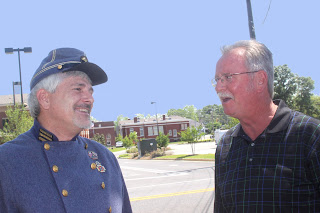The cheers of Fort Sumter had all but died. The tears of Fort Pulaski flowed as the ladies of Savannah cried. It was war! Fort Pulaski, which had guarded the port city of Savannah and was once planned under the supervision of General Robert E. Lee himself, was under siege, a century and a half today. With strong feelings of invincibility still flowing through their veins, few Savannahians then alive would have believed that before the end of 1864, the entire city of Savannah would be under Union control.
The attack on Fort Pulaski came as absolutely no surprise to anyone. More than a week before the artillery barrage began, newspapers across the Northeast carried a headline that a shelling of Fort Pulaski, an integral part of the attack upon Fort Jackson closer upriver to Savannah, was about to begin.
In his first tour of duty in the United States Army, Robert E. Lee, a former West Point cadet and a lieutenant in the Engineering Corps, began his first assignment - to survey and make plans for forts at the mouth of the Savannah River on Cockspur Island.
When the threat of war between the North and South became all too real, Georgia officials sent a detachment of untested militia to seize Fort Pulaski on January 3, 1861. When the state officially seceded the following month, the bastion became a critical Confederate military installation.
By November 1861, Federal attacks on Confederate forts in South Carolina and Georgia caused Lee to make a hurried trip back to Cockspur Island to formulate plans to protect Fort Pulaski from both naval and ground attacks, as well as the vital ports of Charleston and Savannah.
The mighty fortress, completed in 1847, was situated at an elbow of the meandering Savannah River channel. Planners theorized that any warship entering the area had to set a course dead ahead toward the fort. Col. Charles H. Olmstead, the fort's commander, believed that no ship could get beyond the fort. But that wasn't the plan of Pulaski's attackers.
United States Army General Thomas Sherman, commanding more than twelve thousand men, worked in cooperation with Navy Captain Samuel Dupont, who set up a small armada of gunboats to block any rear attacks. The initial plan was to directly attack the city of Savannah, by bypassing Fort Pulaski altogether.
By Valentine's Day, Federal forces began to tighten the noose around the Confederate stronghold. Five companies of men, totaling some 385 effectives, were left to defend the 7 « foot thick, brick walled fort with 48 guns at their disposal. Union artillery commanders erected nearly a dozen batteries along the northwestern shore of Tybee Island with as many as three dozen guns aimed squarely at the beleaguered bastion.
Union Lieutenant James Wilson brought over a request to the Confederate commander to surrender the fort early on the morning of April 10, 1862. Olmstead politely refused. Just after 8:00 o'clock, the artillery cannonade began. Five batteries opened fire, relentlessly pounding Pulaski and its defenders with as many to four to five rounds per minute.
At first, the rounds missed their targets. But, as forward observers called in adjustments, the rounds became decidedly devastating to the thick brick walls. One observer reported that the conical shells pierced the fort's thick brick walls with ease. One of the first casualties was the fort's flagstaff, which was broken early during the attack.
The hailstorm of iron enfiladed the fort without pause until sunset. Olmstead's gunners, mostly manning mortars outside the fort, returned fire slowly and deliberately aiming at Union batteries on Tybee Island. Throughout the day, the Confederate forces held out hope as some of their rounds struck and disabled a couple of Union ships and a few others were thought to have silenced some of the Union batteries. All through the evening, Union artillerists reminded Pulaski's defenders that the bombardment was just beginning by sending two to three rounds every half hour. No one in the fort slept that night.
Despite thirty hours of the horrific shelling of thousands of rounds, only four men were at first reported to be seriously wounded. Three men lost an arm and one lost a leg. Other reports counted the Confederates mortally wounded to be as many as twenty. Union dead were initially reported at seventeen. That number was later reduced to the death of a single Union artillerist.
Throughout the day, panic among the residents of Savannah crescendoed as the vibrations shook windows throughout the city. Many in the city began preparations to flee westward to inland sanctuaries.
When the devastating effect of the heavy barrage made further resistance futile, the fort's youthful commander, Col. Olmstead, reluctantly decided to surrender his command in the middle of the afternoon of the 11th of April. Olmstead was quoted as saying, "I yield my sword, but I trust I have not disgraced it."
After the unconditional surrender was signed and sealed, the Union flag was raised above the ravaged ramparts of Fort Pulaski. The defenders were taken prisoner and shipped to forts in New York. A total blockade of the port of Savannah was put in place.
In expectation of an attack on Fort Pulaski by rebel forces, six hundred Confederate prisoners, mostly officers and known as the Immortal 600, were imprisoned in Fort Pulaski to prevent a siege by Confederates.
And, it was on this day, one hundred and fifty years ago when the Civil War came to the soil of Georgia for the very first time. The relatively light conflict at Fort Pulaski would be overshadowed by the horrific battle of Chickamauga in September 1863 and the war changing Atlanta Campaign in the spring and summer of 1864. Savannah herself fell into the hands of the Union army when Gen. William T. Sherman's crippling March to the Sea in the autumn of 1864 ended on Christmas Day in 1864.











































